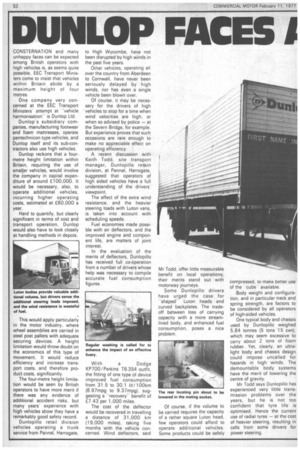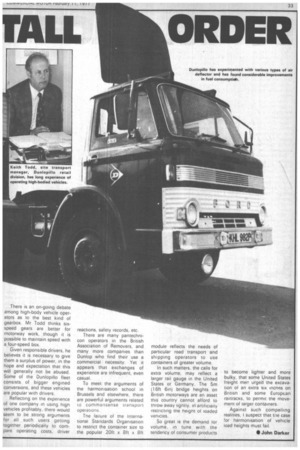DUNLOP FACES I TALL ORDER
Page 34

Page 35

If you've noticed an error in this article please click here to report it so we can fix it.
CONSTERNATION and many unhappy faces can be expected among British operators with high vehicles is, as seems quite possible, EEC Transport Ministers come to insist that vehicles within Britain abide by a maximum height of four metres.
One company very concerned at the EEC Transport Ministers. attempt at -vehicle harmonisation'. is Dunlop Ltd.
Dunlop's subsidiary companies, manufacturing footwear and foam mattresses, operate pantechnicon type vehicles, and Dunlop itself and its sub-contractors also use high vehicles.
Dunlop reckons that a fourmetre height limitation within Britain, requiring the use of smalier vehicles, would involve the company in capital expenditure of around £100,000. It would be necessary, also, to -operate additional vehicles, incurring higher operating costs, estimated at £60,000 a year.
Hard to quantify, but clearly significant in terms of cost and transport operation, Dunlop would also have to look closely at handling methods in depots.
This would apply particularly in the motor industry, where wheel assemblies are carried in steel post pallets with adequate securing devices. A height limitation would throw doubt on the economics of this type of movement. It would reduce efficiency and increase transport costs, and therefore product costs, significantly.
The four-metre height limitation would be seen by British operators to have more merit if there was any evidence of additional accident risks, but many years experience with high vehicles show they have a remarkably good safety record.
Dunlopillo retail division vehicles operating a trunk service from Pannal, Harrogate, to High Wycombe, have not been disrupted by high winds in the past five years.
Other vehicles, operating all over the country from Aberdeen to Cornwall, have never been seriously delayed by high winds, nor has even a single vehicle been blown over.
Of course, it may be necessary for the drivers of high vehicles to stop for a time when wind velocities are high, or when so advised by police — at the Severn Bridge, for example. But experience proves that such occasions are rare enough to make no appreciable effect on operating efficiency.
A recent discussion with Keith Todd, site transport manager, Dunlopillo retain division, at Pannal, Harrogate, suggested that operators of high sided vehicles have a full understanding of the drivers' viewpoint.
The effect of the extra wind resistance, and the heavier steering loads with Luton vans, is taken into account with scheduling speeds.
Fuel economies made possible with air deflectors, and the improved engine and component life, are matters of joint interest.
In the evaluation of the merits of deflectors, Dunlopillo has received full co-operation from a number of drivers whose help was necessary to compile accurate fuel consumption figures.
With a Dodge
KP700/ Perkins T6.354 outfit, the fitting of one type of device improved fuel consumption from 31.6 to 30.1 lit/100km (8.97mpg to 9.37rnpg), suggesting a -recoverybenefit of £7.43 per 1,000 miles.
The cost of the deflector would be recovered in travelling a distance of 31,000 km (19,000 miles), taking five months with the vehicle concerned. Wind deflectors, said Mr Todd, offer little measurable benefit on local operations; their merits stand out with motorway tourneys.
Some Dunlopillo drivers have urged the case for 'shaped' . Luton heads and curved backplates. The tradeoff between loss of carrying capacity with a more streamlined body, and enhanced fuel consumption, poses a nice problem.
Of course, if the volume to be carried requires the capacity of a rather square Luton head, few operators could afford to operate additional vehicles. Some products could be safely
compressed, to make better use of the "'cube'. available.
Body weight and configuration, and in particular track and spring strength, are factors to be considered by all operators of high-sided vehicles.
One typical body and chassis used by Dunlopillo weighed 5.84 tonnes (5 tons 15 cwt), which may seem excessive to carry about 2 tons of foam rubber. Yet, clearly, an ultralight body and chassis design could impose uncalled for hazards in high winds. The demountable body systems have the merit of lowering the centre of gravity.
Mr Todd says Dunlopillo has experienced very little transmission problems over the years, but he is not too confident that lyre life is optimised. Hence the current use of radial tyres -at the cost of heavier steering, resulting in calls from some drivers for power steering. There is an on-going debate among high-body vehicle operators as to the best kind of gearbox. Mr Todd thinks sixspeed gears are better for motorway work, though it is possible to maintain speed with a four-speed box.
Given responsible drivers, he believes it is necessary to give them a surplus of power, in the hope and expectation that this will generally not be abused. Some of the Dunlopillo fleet consists of bigger engined conversions, and these vehicles are popular with drivers.
Reflecting on me experience of one company in using high vehicles profitably, there would seem to be strong arguments for all such users getting together periodically to compare operating costs, driver reactions, safety records, etc.
There are many pantechnicon operators in the British Association of Removers, and many more companies than Dunlop who find their use a commercial necessity. Yet it appears that exchanges of experience are infrequent, even casual.
To meet the arguments of the harmonisation school in Brussels and elsewhere, there are powerful arguments related to commonsense transport operations.
The failure of the international Standards Organisation to restrict the container size to the popular 20ft x 8ft x 8ft module reflects the needs of particular road transport and shipping operators to use containers of greater volume.
In such matters, the calls for extra volume, may reflect a larger rail gauge in the United States or Germany. The 5m 16ft 6m) bridge heights on British motorways are an asset this country cannot afford to tnrow away lightly, in artificially restricting me height of loaded vehicles.
So great is the demand for volume, in tune with the tendency of consumer products to become lighter and more bulky, that some United States freight men urged the excavation of an extra six inches on Britisn and some European raiitracKs, to permit the movement of larger containers Against such compelling realities, I suspect that tne case for harmonisation of vehicle load heights must fail.
• John Darker
























































































































